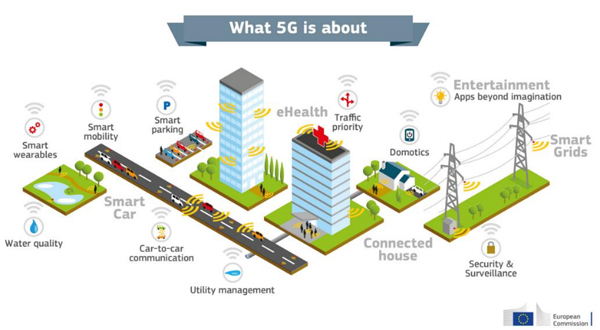The route to 5G has been laid out at this year’s Mobile World Congress in Barcelona. Operators and service providers are now talking about the reality of 5G, how fast it is going to be and what services it will power. And the speeds being discussed mark a genuine sea change in the mobile world.
Various speeds have been mooted, with a tenfold increase in data transmission speeds compared to current 4G capabilities being the most commonly mentioned figure. A number of companies have already conducted successful 5G trials. Verizon’s early tests have speeds exceeding 10Gbps, and with that comes the ability to transmit 4K video on the move. The trials have been carried out in both indoor and outdoor environments and in both residential and commercial buildings, and Verizon announced that commercial deployments could begin as early as 2017.
ZTE Corporation and China Mobile also used MWC to announce their 5G high-frequency prototype and demonstrated a 10Gbps plus high bitrate, beam-tracking and other key 5G technologies. Not wanting to be left behind, the European Union also announced its own coordinated 5G action plan, while the International Telecommunication Union, a UN agency that works with global carriers, said EU member countries had approved a plan on how to harmonize spectrum for 5G, with rollout expected for 2020. Ericsson have even been reporting 5G field trials with peak download speeds reaching as fast as 25Gbps, potentially up to 100 times 4G LTE speeds.
App providers getting involved
Another significant development at MWC was the news that Facebook is appealing to telecoms companies to work with them in 5G development and rollout. The social media giant announced its Telecom Infra Project (TIP), which includes companies like Nokia, Intel, Deutsche Telekom and SK Telecom. TIP is designed to overhaul telecom network infrastructure and get it ready for 5G rollouts. Facebook is prioritizing the network at this stage in preparation for demand for high-bandwidth apps like mobile video using 360-degree cameras and virtual reality (VR), which according to Facebook chief executive Mark Zuckerberg at MWC, will be one of "the killer applications of 5G”.
The new residential broadband?
In a number of countries around the world where deploying fixed line broadband to remote and rural locations has been made difficult by basic geography and cost, 4G mobile broadband has been used to connect them up. The speed and reliability of 5G has prompted some operators to advocate it as a replacement for residential broadband in mainstream markets.
One of the elements of the Verizon tests was that the network ran at both 73GHz and 28GHz, effectively providing a ‘fixed wireless broadband’ service. The focus of this trial was to see whether or not wireless 5G connectivity could actually replace wired broadband services to residential and commercial buildings. It looks like something which could become a real possibility.
But it’s about more than just speed
The massive capacity offered by 5G has also seen some operators suggesting it could even form the new Internet of Things (IoT) network infrastructure. 5G also offers low latency, meaning not only will both download and upload speeds be fast, but response times for initiating data transfers will be similarly rapid – in end-user terms this means that there will be a shorter delay between starting a video streaming and the high-definition 4K video beginning to play on your mobile device.
The much increased speed and capacity and lower latency of 5G also offer operators more opportunity to innovate, and think about what new service offerings they might take to market. End-users now demand and expect more than ever, so the onus is on operators to evolve their existing mobile broadband business models and take advantage of 5G and ultimately justify their investments in it.
Customer experience to be key
The fact is now that end-users, particularly those of the digital native generation, simply expect connectivity to be there. They take it as a given. And as mobile connectivity gets faster and reaches 5G’s super speeds, their expectations of the experience they will have increase too.
As such mobile service providers will need to understand that 5G doesn’t just mean faster and more capacity – it means delivering better services and solutions to more machines than ever. In addition to smartphones the mobile universe and IoT will now incorporate wearables, home appliances, the connected car and much more, so the context in which end-users are engaging online changes. Connectivity is no longer the sole selling point to consumers, the solutions and the customer experience are both now key. As pointed out at an MWC round table by AT&T’s Ralph de la Vega, “We can’t sell connectivity – we have to sell solutions. That will make 5G more competitive and successful.”


I’ve been writing about technology for around 15 years and today focus mainly on all things telecoms - next generation networks, mobile, cloud computing and plenty more. For Futurity Media I am based in the Asia-Pacific region and keep a close eye on all things tech happening in that exciting part of the world.